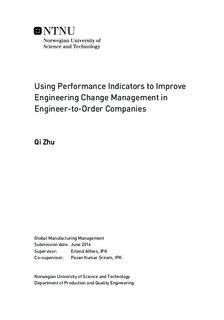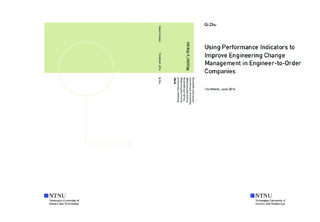| dc.description.abstract | Purpose The purpose of this thesis is to develop performance indicators that can be applied to improve the performance of ECM in ETO companies.
Design The thesis is based on a structured literature study among ETO, ECM, and performance indicator together with the case study among an ETO company.
Findings The findings were presented in this order: (1) the challenges that ETO companies have in terms of product, process, customer, and supply for ECM; (2) ECs in ETO companies have the complex characteristics in terms of volume, reason, occurring phase, priority, and impact which make ECM in ETO companies even more challenging. (3) Current practices of ECM varies regarding ECM process, organizational structure, and tools used to support ECM. It has further shown that despite there are various methodologies and techniques have been proposed both in theory and practice for improving ECM, few is suitable for managing complex ECs in ETO context according to their own characteristics while providing improvement in both overall and local performance of ECM process. (4) Existing performance measurements on ECM are not suitable for improving ECM in ETO because, firstly, they focus on their own contributions not for improving ECM in ETO companies. Secondly, they focus on part of the scope of ECM performance which might result the sub-optimization. Thirdly, most of them are subjective and absolute which cannot reflect the performance in an objective and relative way. (5) A reference framework was developed to visualize the ECM process, provide basis for monitoring and controlling the performance, as well as enable the flexibility to handle ECs according to their own characteristics. It can also be applied to improve the configuration of ECM process. (6) A set of performance indicators were developed based on the reference framework to assess the performance of ECM in both overall and local level, which helps the decision-making on improving ECM.
Research limitations (1) The proposed methodology is applicable for ETO companies in a general situation, further adaption is required to apply it into particular company. (2) The proposed methodology is based on ETO context. Functionalities and features within the new methodology may not fit well in other production strategy. (3) A considerable workload is required to use the performance indicators in both overall and local level. Computer-aided system can be helpful to reduce the workload.
Value (1) The thesis identifies the-state-of-the-art of research in ECM. (2) It reveals the current practice of ECM in ETO company both theoretically and practically. (3) A reference framework was developed to visualize the ECM process, provide basis for monitoring and controlling the performance, as well as enable the flexibility to handle ECs according to their own characteristics. It can also be applied to improve the configuration of ECM process. (4) A set of performance indicators were developed based on the reference framework to assess the performance of ECM in both overall and local level, which helps the decision-making on improving ECM.
Keywords Engineer-to-Order, Engineering Change Management, Performance Measurement, Performance Indicators. | |

